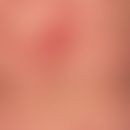Synonym(s)
HistoryThis section has been translated automatically.
Hebra, 1868
DefinitionThis section has been translated automatically.
The term "erythroderma" is a purely descriptive term for a uniform, universal reddening of the skin (affecting > 90% of the skin organ), as a common final stage of various inflammatory diseases.
Erythroderma is usually accompanied by pronounced scaling and intense itching (> 90% of patients), less frequently by oozing.
The pathogenesis of erythroderma is based on a severe inflammation of the skin with serious effects on the entire organism. It is not possible to draw conclusions about an underlying disease from the erythrodermic condition per se. The etiologic classification is only possible after appropriate examinations.
In principle, erythroderma should be regarded as a serious, usually life-threatening condition.
Patients with neonatal erythroderma should be regarded as special clinical cases, as this condition is potentially life-threatening in newborns and young infants due to heat loss, transepidermal water loss and the risk of transcutaneous infection.
You might also be interested in
ClassificationThis section has been translated automatically.
Erythroderma is divided into primary (arising de novo) and secondary erythroderma (arising on the basis of a pre-existing dermatological disease).
- Primary erythroderma(s = very rare):
- Acute primary erythroderma (developed de novo in response to current events):
- Toxic erythroderma (erythrodermic dermatitis, e.g. due to burns, scalds, UV-damage, chemical burns)
- Drug reaction, adverse
- Pustulosis acute generalized exanthematous (AGEP)
- toxic epidermal necrolysis (TEN)
- Anticonvulsant hypersensitivity syndrome.
- Chronic primary erythroderma (congenital- see also erythroderma, neonatal):
- Rare congenital ichthyoses (see ichthyoses below).
- Ichthyosis lamellosa
- CHILD syndrome(s)
- Erythrodermia congenitalis ichthyosiformis bullosa(s)
- Ichthyosis congenita gravis (Harlequin fetus)(s)
- Keratitis-ichthyosis-deafness syndrome (= KID)(s)
- Severe dermatitis-multiple allergies-metabolic loss syndrome (=SAM syndrome)(s)
- Refsum syndrome(s)
- Sjögren-Larsson syndrome(s)
- Immunodeficiencies, T-cellular, primary.
- Chronic primary erythroderma (acquired, insidious onset):
- Sézary syndrome
- T- and B-cell lymphomas
- Leukemias
- Senile erythroderma (idiopathic erythroderma; senile erythroderma of man/red man syndrome)
- Acute primary erythroderma (developed de novo in response to current events):
- Secondary erythroderma (on the ground of a pre-existing disease!)(s = very rare):
- Psoriasis vulgaris (60% of secondary erythroderma)
- Atopic dermatitis
- Seborrheic dermatitis
- Impetigo herpetiformis(s)
- Lichen planus exanthematicus(s)
- Dermatitis, chronic actinic(s)
- Pityriasis rubra pilaris(s)
- Pemphigus foliaceus(s)
- Pemphigus, paraneoplastic (s)
- Pemphigoid, bullous
- Dermatomyositis
- Lupus erythematosus, systemic
- IPEX syndrome/mutation in FOXP3
- Comel-Netherton syndrome/mutation in SPINK5
- OMENN syndrome/RAG1/2
- SCID(s)
- Scabies norvegica(s)
- Hypereosinophilia syndrome(s)
- Melanoerythroderma a.o. as paraneoplastic syndrome(s)
- Papuloerythroderma (Ofuji)(s).
Occurrence/EpidemiologyThis section has been translated automatically.
Epidemiological data on erythroderma are unreliable. Prevalences vary from 0.9/100,000 for Europe to 35/100,000 in India.
ManifestationThis section has been translated automatically.
HistologyThis section has been translated automatically.
The diagnostic value of a histological examination must be considered in a differentiated manner. Often the histological result is uncharacteristic. In the case of congenital erythroderma, histological examination may be diagnostically groundbreaking. Lymphomas of the skin can be clearly diagnosed. In the case of secondary erythroderma, clues to the underlying disease may be found.
Histological examination: an important prerequisite for a meaningful histological examination is a long-term discontinuation of any therapy with glucocorticoids (external as well as internal).
DiagnosisThis section has been translated automatically.
Systematics with auxiliary word "SCALPID
- S = Sezary syndrome, Scabies crustosa, SCLE
- C = contact dermatitis
- A = atopic dermatitis
- L = lymphoma (cutaneous T-cell lymphoma), lymphocytic leukemia, lichen planus
- P = psoriasis, pityriasis rubra pilaris, pemphigus foliaceus, paraneoplasia
- I = Ichthyosis
- D = Drugs (drug reactions)
Complication(s)This section has been translated automatically.
For the skin and the entire organism, erythroderma, regardless of the causative underlying disease, represents a severe burden, especially due to:
- Significantly increased skin perfusion with consecutive cardiovascular stress.
- Excessively increased heat radiation (constant freezing of the patient).
- Disturbance of the skin barrier with increased loss of fluidity.
- Increased desquamation with increased loss of albumin and proteins.
- Unspecific disturbance of the immunological defense with increased tendency to infections.
TherapyThis section has been translated automatically.
LiteratureThis section has been translated automatically.
- Borrás-Blasco J et al.(2001) Erythrodermia induced by omeprazole. Int J Clin Pharmacol Ther 39:219 w23.
- Iliescu V et al.(1997) Erythrodermia Sézary with immunological deficiency and antibodies against human albumin. Acta Med Scand 197(1-2):141-144. Kiessling W et al.(1959) Melano-erythrodermia with cachexia. Arch Klin Exp Dermatol 208:579-591.
- Mori S et al. (1988) Postoperative erythrodermia (POED), a type of graft-versus-host reaction (GVHR)? Pathol Res Pract 184:53-59.
- O'DONOVAN WJ (1950)Exfoliative erythrodermia with lymphadenopathy. Proc R Soc Med. 43:563-564.
- Oztas P et al. (2006) Imatinib-induced erythrodermia in a patient with chronic myeloid leukemia. Acta Derm Venereol 86:174-175.
- Sequeira JH (1919) Case of Erythrodermia with Lymphatic Leukaemia. Proc R Soc Med.12(Dermatol Sect):54-56.
- Wigley JE (1947) Exfoliative Erythrodermia with Marked Pigmentation. Proc R Soc Med 40:246-247.
Incoming links (43)
Actinic reticuloid; Alterserythrodermia; Anonychie acquired; Atopic erythroderma hill; Autosomal recessive ichthyosis lamellosa with transglutaminase deficiency; Candidosis, congenital cutaneous; Carbamazepine; Dermatoses, erythematosquamous; Dress; Drug reaction lymphocytic; ... Show allOutgoing links (38)
Acute generalized exanthematous pustulosis; Adverse drug reactions of the skin; Anticonvulsant hypersensitivity syndrome; Atopic dermatitis (overview); Child syndrome; Chronic actinic dermatitis (overview); Comel-netherton syndrome; Cutaneous non hodgkin lymphomas; Dermatomyositis (overview); Epidermolytic ichthyosis; ... Show allDisclaimer
Please ask your physician for a reliable diagnosis. This website is only meant as a reference.



























